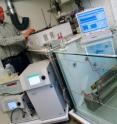Particulate emissions from laser printers
We regularly hear reports that laser printers release pathogenic toner dust into the ambient air. How much of it can we believe? What kind of particles do the printers really emit, and in what quantities? Researchers at the Fraunhofer Wilhelm Klauditz Institute WKI in Braunschweig are investigating this question in collaboration with colleagues from Queensland University of Technology QUT in Brisbane, Australia. The results are surprising: Contrary to numerous reports, laser printers release hardly any particles of toner into the air. "But what some printers do emit are ultra-fine particles made of volatile organic-chemical substances," says WKI head of department Prof. Dr. Tunga Salthammer. "One essential property of these ultra-fine particles is their volatility, which indicates that we are not looking at toner dust." So where do these ultra-fine particles come from? And how can their emergence be explained? To discover the answer, the scientists have developed a process that enables them to determine and compare the quantity, size and chemical composition of the emitted particles. Technical and financial support was provided by the printer and copier manufacturers in the German Association for Information Technology, Telecommunications and New Media (BITKOM). Depending on their dimensions, the printers are housed in a test chamber measuring one or 24 cubic meters. Particle analyzers count the particles and measure their size distribution. To discover the source, the researchers also examined modified printers that "print" without any paper or toner. "The amazing thing is that the ultra-fine particles are still produced even in this case. The cause is the fixing unit – a component that heats up as high as 220°C during the printing process in order to fix the toner particles on the paper," explains WKI scientist Dr. Michael Wensing. The high temperatures cause volatile substances such as paraffins and silicon oils to evaporate, and these accumulate as ulta-fine particles. The scientists from Braunschweig observed similar phenomena – the formation of ultra-fine particles of volatile organic substances when heated – during typical household activities such as cooking, baking, or making toast. Filters are available on the market to reduce these printer emissions. But are they any use? "Our investigations show that the various external filters on offer for printers operate in very different ways. As the ultra-fine particles are not emitted from a specific part of the printer, but also from the paper output, for instance, a filter can only have a limited effect."
Source: Fraunhofer-Gesellschaft
Other sources
- Particulate Emissions From Laser Printersfrom Science Daily16 years ago
- Do laser printers emit harmful particles?from Physorg16 years ago


